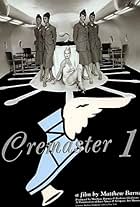An experimental short film from the Cremaster series which alludes to the position of the reproductive organs during the embryonic development process.An experimental short film from the Cremaster series which alludes to the position of the reproductive organs during the embryonic development process.An experimental short film from the Cremaster series which alludes to the position of the reproductive organs during the embryonic development process.
- Director
- Writer
- All cast & crew
- Production, box office & more at IMDbPro
Featured reviews
I liked this Cremaster movie the best. First of all, it's nice and short. Second, the visual imagery is simple, yet interesting, not the overkill of Cremaster 3. Lastly, it's probably the most "fun" of the Cremaster films to watch (if you can describe any of them as fun). There's no plot, of course, and it's extremely pretentious, but it held my attention for all 42 minutes, and I'd recommend it as a stand-alone art film. 8 out of 10.
Cre·mas·ter
noun 1.
ANATOMY the muscle of the spermatic cord, by which the testicle can be partially raised.
2. ENTOMOLOGY the hooklike tip of a butterfly pupa, serving as an anchorage point.
This inceptive entry of the 5-part series plays like a low-budget Charley and the Chocolate Factory with buff, nude Oompa Loompas who exist circuitously in a Teletubbies-esque environment, but if the show's creators had been on copious amounts of methamphetamines. We primarily witness a crosscutting between a tap-dancing devil figure - who eventually must crawl through a viscous, uterine tunnel, as if being born into the world - and two separate, futuristic race cars which speed off from each other in opposite directions. A Lynchian sound design plays over Cronenbergian visuals - one example of which is gelatinous embryos that ooze from the pockets of the race car drivers, whose midsections are shot at a close up to appear like separate, slimy organisms. Barney's medium combines filmic techniques, with 3D art-instillations, and stop motion to create a singular pastiche. Plotless and entirely absurdist, this series, I can tell, will be perfect for me but certainly not for everyone. The final shot is of a close up of a pair of testicles being stimulated by prolonged metal objects. Enter into the Cremaster Cycle at your own discretion.
noun 1.
ANATOMY the muscle of the spermatic cord, by which the testicle can be partially raised.
2. ENTOMOLOGY the hooklike tip of a butterfly pupa, serving as an anchorage point.
This inceptive entry of the 5-part series plays like a low-budget Charley and the Chocolate Factory with buff, nude Oompa Loompas who exist circuitously in a Teletubbies-esque environment, but if the show's creators had been on copious amounts of methamphetamines. We primarily witness a crosscutting between a tap-dancing devil figure - who eventually must crawl through a viscous, uterine tunnel, as if being born into the world - and two separate, futuristic race cars which speed off from each other in opposite directions. A Lynchian sound design plays over Cronenbergian visuals - one example of which is gelatinous embryos that ooze from the pockets of the race car drivers, whose midsections are shot at a close up to appear like separate, slimy organisms. Barney's medium combines filmic techniques, with 3D art-instillations, and stop motion to create a singular pastiche. Plotless and entirely absurdist, this series, I can tell, will be perfect for me but certainly not for everyone. The final shot is of a close up of a pair of testicles being stimulated by prolonged metal objects. Enter into the Cremaster Cycle at your own discretion.
Glacial pacing and ridiculous mythopeia are more than compensated by the uniqueness of his vision, and the gutsiness of his approach. Well worthwhile for discerning viewers. Lovely music, great sets, but it's really a filmed document of his static art.
I'm seeing these in numeric order, which I must assume was some sort of intent. So far, the first was important and effective. It mattered to me. The second was overloaded with storysense that showed flat stupidity. The third was similar but overloaded with random symbols. Along the way, I saw "Drawing Restraint" and it was every bit as good as number 1.
The advantage of this is that the symbols are few, the symbolic structures simple and obvious, the posturing plain. Its still uninteresting. He's still not a deep man unless he thinks in images, environments rather than objects.
In this case, there's a race, an underground vagina and a sterile terminus for both.
Boring.
Ted's Evaluation -- 1 of 3: You can find something better to do with this part of your life.
The advantage of this is that the symbols are few, the symbolic structures simple and obvious, the posturing plain. Its still uninteresting. He's still not a deep man unless he thinks in images, environments rather than objects.
In this case, there's a race, an underground vagina and a sterile terminus for both.
Boring.
Ted's Evaluation -- 1 of 3: You can find something better to do with this part of your life.
The Cremaster Cycle 9/10 The Cremaster Cycle is a series of five films shot over eight years. Although they can be seen individually, the best experience is seeing them all together (like Wagner's Ring Cycle) - and also researching as much as you can beforehand. To give you an idea of the magnitude, it has been suggested that their fulfilment confirms creator Matthew Barney as the most important American artist of his generation (New York Times Magazine).
The Cremaster films are works of art in the sense that the critical faculties you use whilst watching them are ones you might more normally use in, say, the Tate Modern, than in an art house cinema. They are entirely made up of symbols, have only the slimmest of linear plots, and experiencing them leaves you with a sense of awe, of more questions and inspirations than closed-book answers. The imagery is at once grotesque, beautiful, challenging, puzzling and stupendous. Any review can only hope to touch on the significance of such an event, but a few clues might be of interest, so for what it's worth ...
Starting with the title. The 'Cremaster' is a muscle that acts to retract the testes. This keeps the testes warm and protected from injury. (If you keep this in mind as you view the piece it will be easier to find other clues and make sense of the myriad allusions to anatomical development, sexual differentiation, and the period of embryonic sexual development - including the period when the outcome is still unknown. The films, which can be viewed in any order (though chronologically is probably better than numerically) range from Cremaster 1 (most 'ascended' or undifferentiated state) to Cremaster 5 (most 'descended'). The official Cremaster website contains helpful synopses.)
Cremaster 4 is closest to the biological model and so sets the scene, suggesting the system's onward rush. There is a motorcycle race and a Candidate who is tap-dancing his way through the floor (weird? yes - but it is definitely art, not weird for weird's sake!)
The Guggenheim Museum (which houses a parallel exhibition) describes the Cremaster Cycle as "a self-enclosed aesthetic system consisting of five feature-length films that explore processes of creation." As film, the Cremaster Cycle is one to experience in the cinema if you have the opportunity to do so, or to experience and re-experience at leisure on DVD (the boxed set is promised for late 2004 and will be a gem for lovers of art-cinema fusion).
The Cremaster films are works of art in the sense that the critical faculties you use whilst watching them are ones you might more normally use in, say, the Tate Modern, than in an art house cinema. They are entirely made up of symbols, have only the slimmest of linear plots, and experiencing them leaves you with a sense of awe, of more questions and inspirations than closed-book answers. The imagery is at once grotesque, beautiful, challenging, puzzling and stupendous. Any review can only hope to touch on the significance of such an event, but a few clues might be of interest, so for what it's worth ...
Starting with the title. The 'Cremaster' is a muscle that acts to retract the testes. This keeps the testes warm and protected from injury. (If you keep this in mind as you view the piece it will be easier to find other clues and make sense of the myriad allusions to anatomical development, sexual differentiation, and the period of embryonic sexual development - including the period when the outcome is still unknown. The films, which can be viewed in any order (though chronologically is probably better than numerically) range from Cremaster 1 (most 'ascended' or undifferentiated state) to Cremaster 5 (most 'descended'). The official Cremaster website contains helpful synopses.)
Cremaster 4 is closest to the biological model and so sets the scene, suggesting the system's onward rush. There is a motorcycle race and a Candidate who is tap-dancing his way through the floor (weird? yes - but it is definitely art, not weird for weird's sake!)
The Guggenheim Museum (which houses a parallel exhibition) describes the Cremaster Cycle as "a self-enclosed aesthetic system consisting of five feature-length films that explore processes of creation." As film, the Cremaster Cycle is one to experience in the cinema if you have the opportunity to do so, or to experience and re-experience at leisure on DVD (the boxed set is promised for late 2004 and will be a gem for lovers of art-cinema fusion).
Did you know
- ConnectionsEdited into The Cremaster Cycle (2003)
Details
- Release date
- Countries of origin
- Official site
- Language
- Also known as
- Кремастер 4
- Filming locations
- Production companies
- See more company credits at IMDbPro
Contribute to this page
Suggest an edit or add missing content
















